“Double Headed South: Bicephalous” is the exhibition of Javier Tapia and Peter Bonde that seems to be lifted from the cultural crossroads between them. Certainly there are many other inspirations that led them to translate their thoughts and energy to this project.
Text & interview: Carolina Martínez Sánchez | Images: Josefina Lagos | Translation: Ana Rosa Ibañez
The classic discussion of form versus content seems senseless in a time were any kind of limit, or even, any kind of definition is diffuse and malleable. It’s true that dialogues and their different forms are transiting faster than ever, and it’s because of this that our postmodern spirits may attribute to them any sense that we want. The constant contradiction between living and coexisting in dissimilar sections, from a first surface, speaks of belonging to the same structure.
“Double Headed South: Bicephalous” is the bi-personal show of the Denmark-based Chilean visual artist Javier Tapia and the Danish artist Peter Bonde and is being shown at the Fine Arts Museum of Chile and also D21 Gallery. The exhibition seems to be put together from the cultural crossing between Javier and Peter, taking as a central figure in the installation an inflatable sculpture that refers a double entry Columbian pot, with two alcohol bottles coming out of its entries and set over a huge structure of iron and scaffolding. Bonde’s exquisite paintings cover the structure in certain bits, acting as separators in other sections.
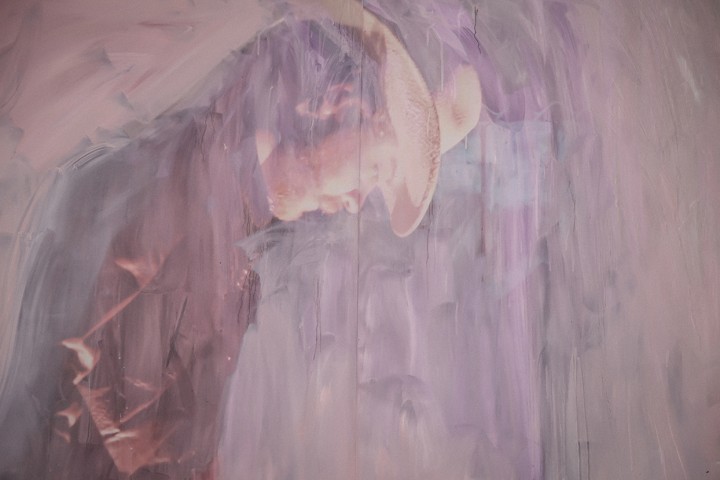
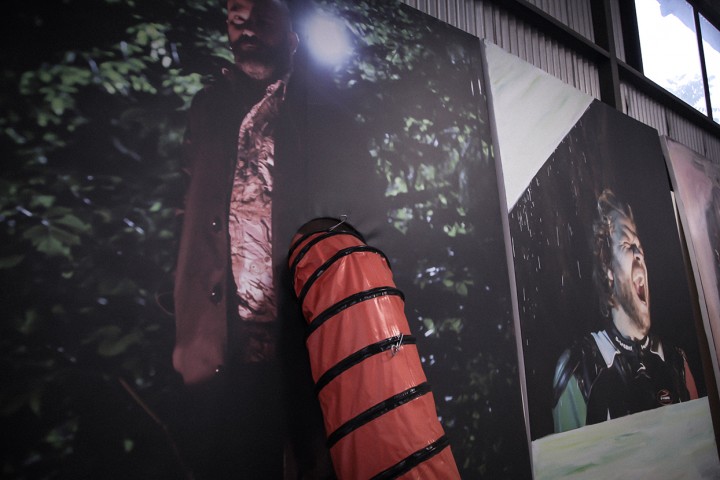
It’s a small world what we find inside the museum, where the scaffolding aren’t just containing the elements that configure “Double Headed South”, but are also part of the system, becoming a model that supports the construction of dialogue and the energy of objects and symbols. Within it, a film is projected which insists in taking us to Javier’s and Peter’s journey from Denmark, and in which the projection cubicle is connected by a large tube to another section of the installation, shaped by the inanimate reproduction of the Scandinavian landscapes where the film was shot, but evoking quite an organic perception in its materials.
Without any doubt, in a first moment the exquisite recollection and peculiar mix that the artists deliver, speaks of found object that turned into allegories and some other elements that belong to a Anglo-Saxon, schemed system. The fact is, “Double Headed South” goes much further than being just an installation conceived from the global paradigm of transiting and confounding cultures. We find energy here, and a very powerful one, that nourishes from different elements and places, and that may not ever end.
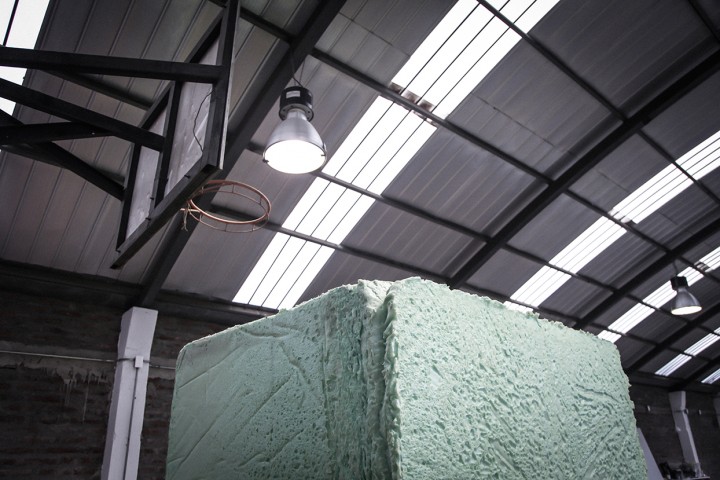

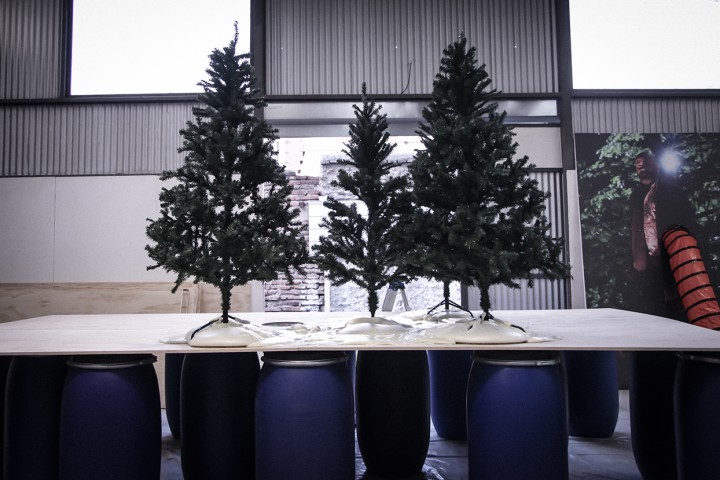
Javier Tapia’s work is like a chain of things that he himself does not know when will it end. In each project, he ads stuff that configure as a learning experience, trying also to learn from other who may have more knowledge than him. This is why his work in a way, looks like hasn’t been finished. Nothing is forced or planned, he might use different platforms such as film, sculpture and installation; and it’s really passion and interest what really runs through each one of his projects.
“Sometimes something interests me, but I try no to force it like a determined form. I don’t care if I’m working on a film, installation, sculpture, drawing or a complete scene. I just try to work with interest and passion with no doubt.”
That is how experimentation and a sort of “rehearse and error scientific method” operates in his processes. There are certain factors given by the context that may work or not, that way the adjust to this learning and to the natural happening of matters.
To talk about what inspires Javier, we need to look through the emotional scope, circumstances, casualties or people that show up in every stage. Maybe a highly energetic moment, or a somewhat more nostalgic one may give him some light. His work has nourished from energy and intuition.
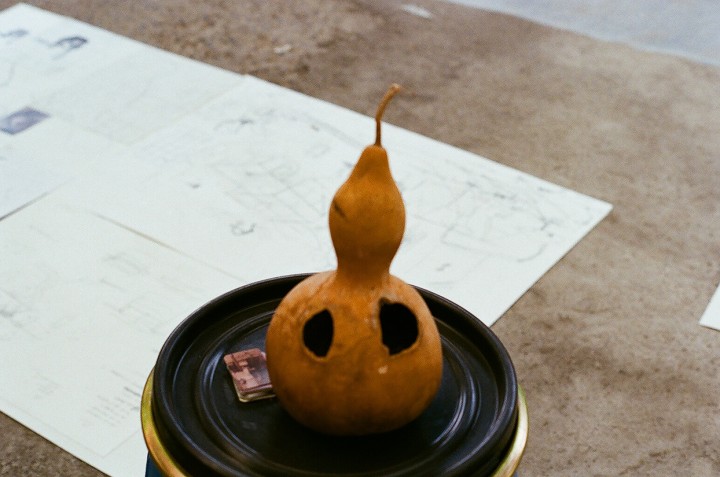
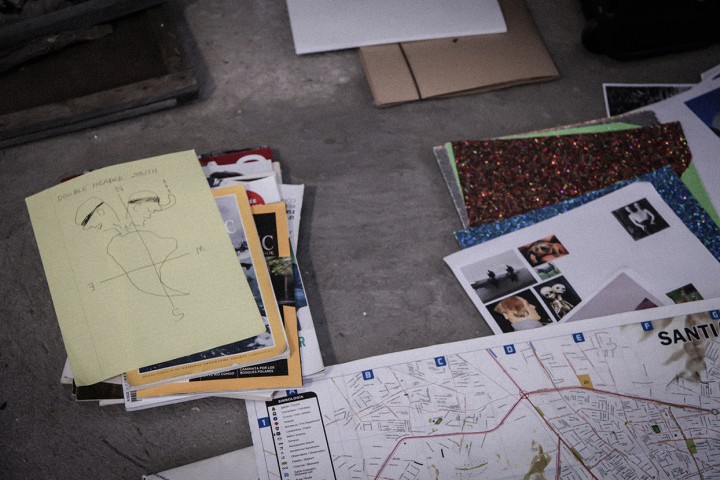
But it’s not only about reflexing around culture and society and the elements that rule the content that Javier develops in a in a “becoming” form; it’s also about a movie, about the other artist’s character or simply some good conversation from where the artist traces the lines for his next work.
Just like this is how he got the idea of leaving. It wasn’t planned, although he was being influenced form what was happening with art abroad. A sort of flow that, supported by his family and motivated by his friends, led him to start a journey. Knowing new places and people is something that has also been preponderant in the way he leads his projects, not only in the aesthetics but in collaborations also.
“When I get to a new country without knowing anything of the place, I try to meet new people and generate relations. Sometimes I find metaphors in thing that are not part of my speech, but are similar in repertoire or just interest me, and they become part of my work.”
Javier Tapia’s pieces are presented almost has visual devices where diverse elements, techniques and supports create interstices that are marks of his journeys, connections and character. He also admits that they might have been influenced by similar factors if he had staid within the country, but it’s hard to imagine the aesthetics and plastic outcomes of that. He uses the most familiar tools, but he also improvises with the ones that appear during a project, responding to a language that is being co-created between the production of the piece and the piece itself. This is how, in perspective, we find a line between his works, where the starting point is always remembering himself.
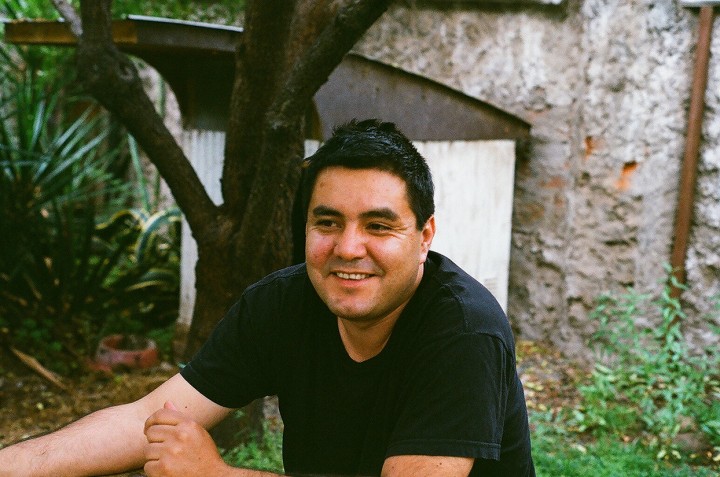

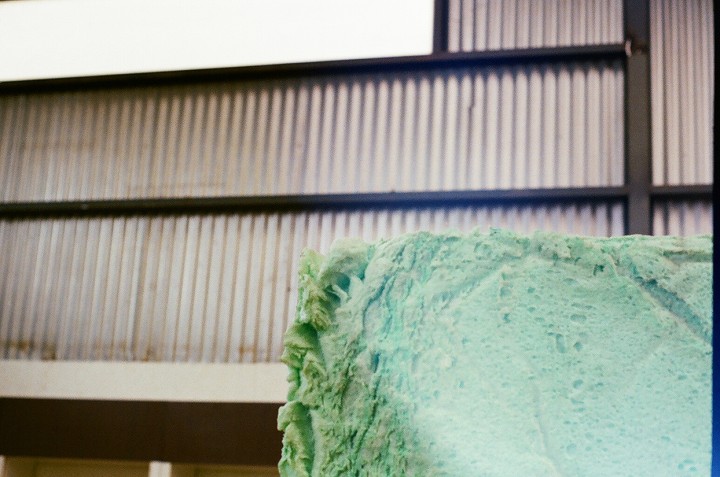
Being in a confusing limit of cultural and individual expression, it’s almost impossible not to place Tapia’s body of work in a political context. Not in an explicit way of making art. Talking and communicating from art and its possible meanings from within a net of different worlds, its affected by a political symptomatology.
“I’m interested in the impact of the post-colonial war, or the first and second class citizens. I’m struck by this situation often as an immigrant in Denmark, but not as something negative. I just notice the difference. I try to use some aspects of it, not in a positive or negative way, just as an aspect of my work. I’m interested in the unspoken levels of the conversation. Sometimes when you visualize the matter, or you are just too obvious, people tend to focus and talk about it.
His history relating to Peter doesn’t defer much of his own history as an artist, where the crossing of thoughts and momentums propitiated the relationship. They both attended the Royal Danish Academy of Fine Arts, where Peter also acted as a teacher. In a moment they were represented by the same galleries and were running into each other at Copenhagen’s openings. The conversations revolved around their travels, what they has observed and of course, projects. For Javier Tapia, Bonde wasn’t someone that was caught up in painting as a way of production, but just as a resource for Peter’s free spirit, and that was actually quite unusual.
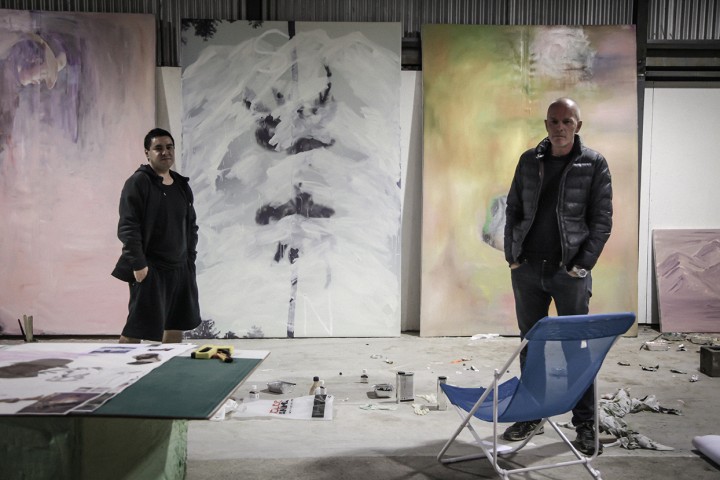

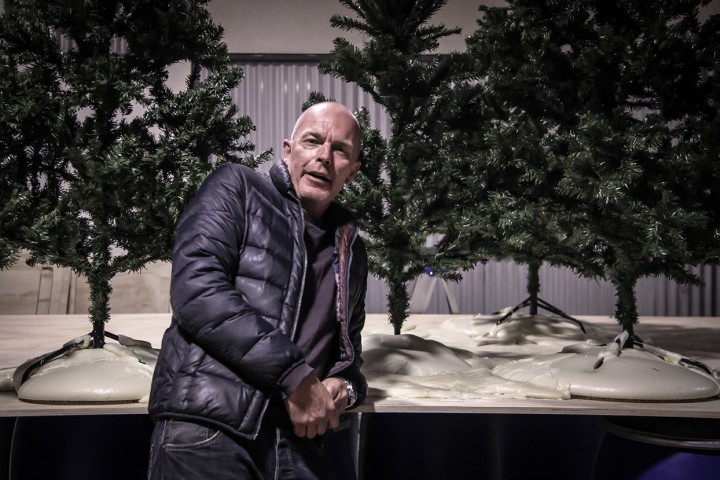
The idea of collaborating was born of one of these encounters, but it wasn’t until they set a deadline that the project came together. Until then, their meeting and ideas were just rambling in pieces of paper. Sometimes you can get ideas from someone when you meet their work, but these dynamics are also conditioned by the situation:
“Persons are complex, each person has it’s own issues. You can meet their family and where they live, and then know them in a more personal level. Not just openings and launchings. That’s how with Peter we started to know each other, and the possibilities of making the project started broadening.”
In that sense, the collaboration process for Peter has been talking, developing ideas. Although this is essential, the way of making something coexist is even more. It’s about finding a solution when things aren’t working; it’s a matter of existence:
“This is really going from one to the other. We don’t need to work in the same pieces all the time, actually we just do that in some of our works, but this detail is not important because the idea of what we want to is a sort of entertainment, where we provide coherent shows to galleries and museums. This is why a better collaboration between the spaces and artists needs to exist, a fluid dialogue; sometimes it can be hard, I know. But sometimes the situation won’t be faced.”
The project that’s got them in Chile, no doubt starts from the inflatable double-entranced vessel, and where the name of the exhibition left in evidence the clues to follow in order to finish structuralizing the spirit of the piece. On top of this, this “bicephalous” idea of two heads looking south. Each one of them in opposition to the other, but in this case, both of them looking at the same place.
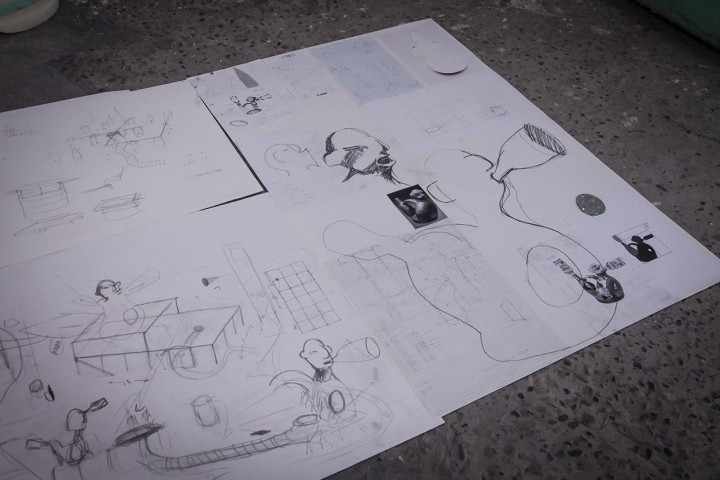
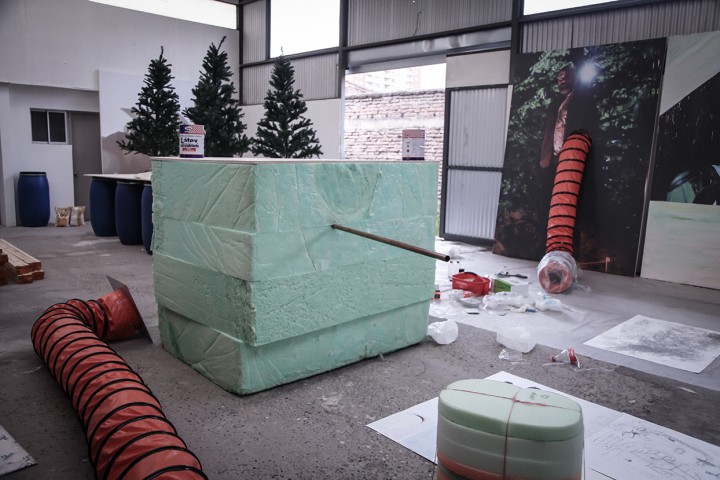
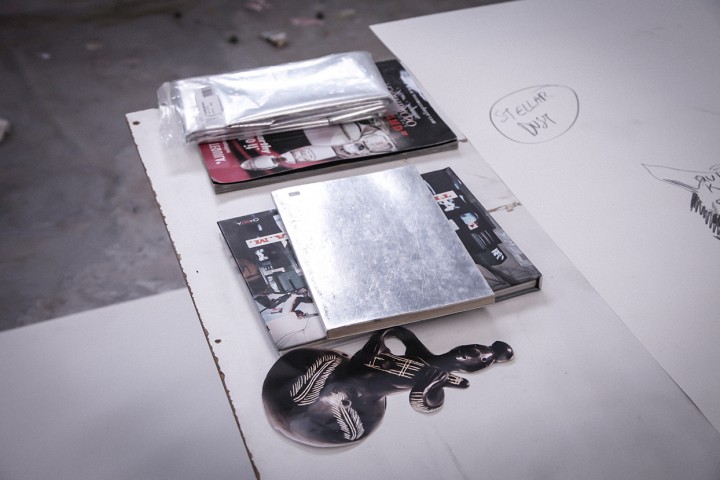
Double Headed South, in the words of other artists, is a kind of study; it’s not trying to explain anything, or being academic. Its about how we have apprehended from this colonized world not only through other cultures, but through substances that were supplied by the conquest itself. For Bonde, this is where his interest started and the perspective on how to propose the project:
“It’s not necessary to tell a story or explain it to no one. It’s just my engine, as a thought after my work. I had this vision of this sculpture with two bottles and then I thought of it and started thinking what I would do with it.”
They both had the urge of including everything: paintings, images of Denmark and Chile, besides the scraps and waste that came of the process. But what helped to land the exhibition was the film, giving a new a stronger impulse, even more than the sculpture in Bonde’s opinion.
The film, the paintings and images of Denmark and Chile and of their lives; the pines the tube the sculpture and the recollected objects and whatever brings us closer to this investigation journey, that is still taking place in Chile. The transmission through something that’s still adapting within the country, but that starts all over from Janus, the bicephalous god of beginnings and endings, talks about two dissimilar aspects. From these different places is that the montage of each other’s work don’t force them to develop an in-common discourse.
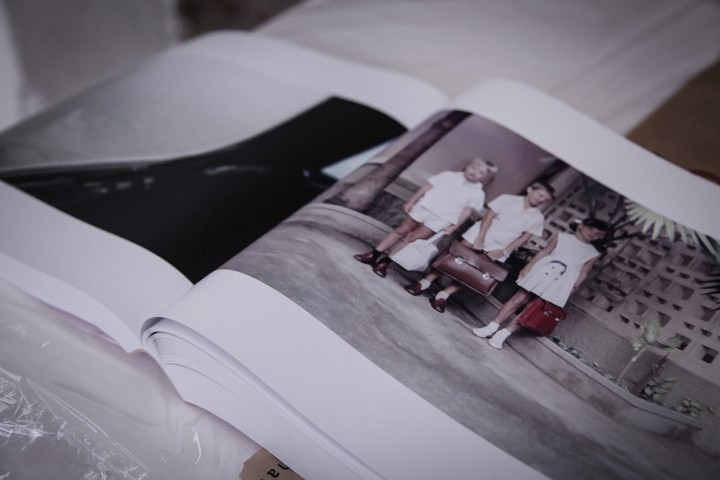
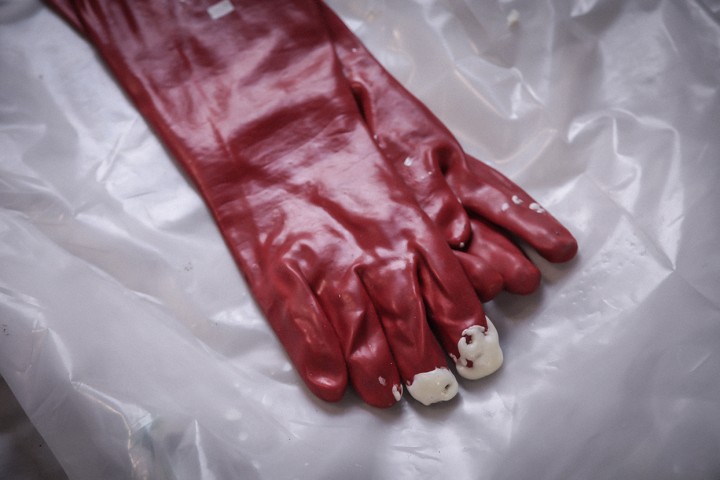
“I don’t know if my work necessarily speaks with Javier’s work.” Bonde says. His interest in the work is not about the final piece, but of the energy, and in his eyes, Javier has a really good one:
“You might like or not the work of someone else, but it’s the thing behind it what’s powerful, the energy, which is a kind of development of something, and that’s how I feel work. It’s not about me relating to Javier’s work, but to his brain. It’s not necessary to produce the work, the artist’s experience or working for the audience. I think it’s more about the dialogue, the energy underneath; and for me, is how I encounter the energy in Javier’s work.”
You might say that his approach to his own work is unfolded in similar layers; he doesn’t divide his work between what’s next to painting and the one of a more objectual character. He admits himself good at painting, but art as a whole is really his interest, taking place in other forms of expression. Is something like meta-inspiration for Peter, being the sole elements, resources and languages of art what propel his work; dialogues are inspirational, the possibility of using different techniques and supports and turning ones into others. A painting can be a text or the mountains he sees in the mornings, or just thinking what his work will be. In his paintings, he usually imports objects that are referents of his personal life, like the book covers of books that have marked him, conforming this sort of index similar to the ones in catholic churches, and also being an excuse to incorporate into his work other figurative elements.
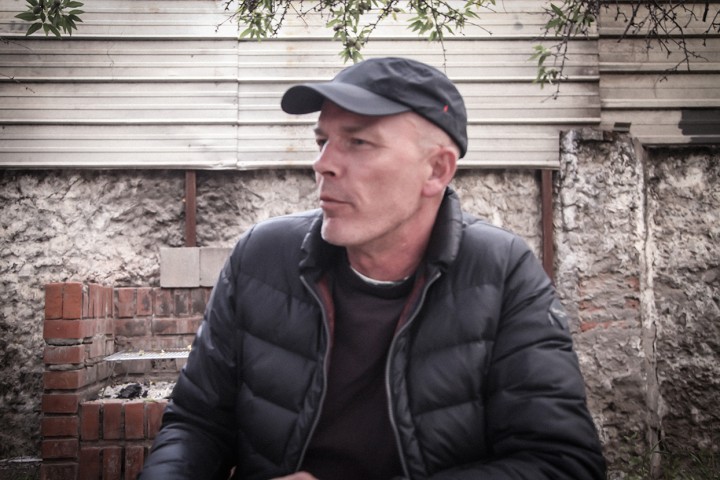
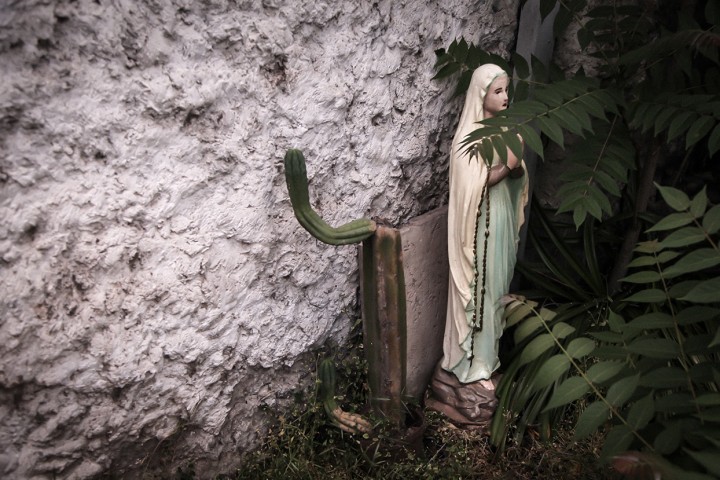
It’s a peculiar manner of evidencing to the audience the world in which he’s immersed but that many times he’s unable of seeing. Peter Bonde has another series where the painting is set upon canvases of a mirror-like reflecting material, modifying or deforming the perception of the user itself when he or she gets near or far, and also the space of the exhibition.
Perception that is meaningful according to where you are. The different levels of symbolic and cultural conversation between Europe and Latin America absolutely differ on how immense or far we can be from each other. For Bonde, the Latin-American way of thinking is very different to what he knows, even having lived in places as Thailand, Venezuela and Los Ángeles. The way you relate and think in our context it’s excessively different in the deepest layers of human behavior, as an individual and as a part of society. He’s not oblivious to the inexistent and surprising class gaps and the disputes between them, or between certain sectors and people that run the countries:
“And in this sense I’m scared of South America. It sounds mad, I know. But I’m scared of how the high class societies here are frightened by people coming from other areas of the city.”
“Double Headed South: Bicephalous” it’s not only an exercise of patenting the different routes and various layers that unite both worlds from a ritual conceptualization of the elements. It’s putting ourselves in front of our eyes, that have become blind under the own visual regime imposed by a industrial and cultural shed, continuous friction and shifting od the connections to our being and to others, reminding us in our faces how far we’ve come from the true dialogue between individuals; and how each one’s essences have alienated us from a structure that should always be diluting the factual boundaries.

 Español
Español